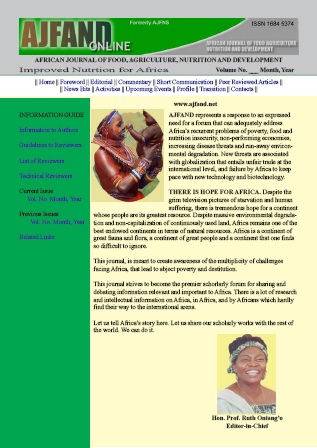
|
African Journal of Food, Agriculture, Nutrition and Development
Rural Outreach Program
ISSN: 1684-5358
EISSN: 1684-5358
Vol. 10, No. 10, 2010, pp. 4124-4138
|
 Bioline Code: nd10102
Bioline Code: nd10102
Full paper language: English
Document type: Research Article
Document available free of charge
|
|
|
African Journal of Food, Agriculture, Nutrition and Development, Vol. 10, No. 10, 2010, pp. 4124-4138
| en |
Traditional Processing, Microbial And Physiochemical Changes During Fermentation Of Malwa
Muyanja, C.; Birungi, S.; Ahimbisibwe, M.; Semanda, J. & Namugumya, B.S.
Abstract
A survey was conducted to characterise production methods of malwa; a Ugandan traditional fermented millet beverage, in four divisions of Kampala district using a questionnaire. Lactobacillus and Lactococcus spp and coliforms were enumerated in the raw materials and during fermentation using standard microbiological methods. Changes in chemical parameters were determined using standard methods. Similarities in production methods were observed among the malwa producers. All producers germinated millet grains (2-3 days) to make green malt. The germinated grains were sun-dried for 2-3 days. Moistened millet flour was subjected to solid state pit fermentation for one week to produce acidified fermented dough. The acidified fermented dough was roasted over an open fire to produce roasted acidified dough. The duration of fermentation of malwa varied between 2 and 4 days. Only 5% of the producers practiced back slopping. Producers (90%) reported that consumers preferred sour malwa. Lactobacillus and Lactococcus spp numbers in the sour dough, roasted sour dough and green malt varied between 3.48 and 5.38, 2.02 and 2.60, and 4.45 and 6.25 log cfug–1 respectively. Coliforms in sour dough, roasted sour dough and green malt varied between 1.36 and 5.53 log cfug–1. Lactobacillus spp increased from 2.73 to 6.60 log cfu mL–1 whereas Lactococcus spp increased from 2.67 to 6.22 log cfu mL–1 during 72 h of fermentation. The greatest increase in numbers was observed during the first 24 h. Coliforms decreased from 2.80 to 1.19 log cfu mL–1 after 24 h with a slight increase to 1.26 log cfu mL–1 after 48 h due to further addition of green malt. Coliforms were still detectable after 72 h. The pH decreased from 4.3 to 3.65 as titratable acidity increased from 0.69 to 1.47% lactic acid after 72 h of fermentation. Total soluble solids decreased from 17.7 to 7.7 oBrix during 72 h fermentation. Ethanol increased from 1.07 to 12% v\v. Carbohydrates and tannins decreased during germination and fermentation. Apparent increase in protein content was observed. The high numbers of Lactobacillus and Lactococcus spp and coliforms in the sour dough suggest their involvement in the solid state pit fermentation of millet flour. Higher numbers of Lactobacillus and Lactococcus spp in the green malt indicates that these organisms play a big role in the fermentation process of malwa.
Keywords
Lactococcus, Lactobacillus, Millet, Fermentation, Malwa
|
| |
© Copyright 2010 African Journal of Food Agriculture, Nutrition and Development.
Alternative site location: http://www.ajfand.net/
|
|
